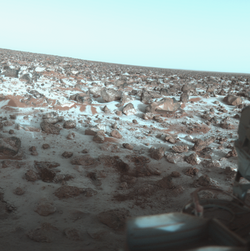Utopia Planitia
| Utopia Planitia | |
|---|---|
 Pohled na část Utopia Planitia na snímku americké sondy Viking 2 | |
| Poloha | 49,7°S × 118,0°V |
| Útvar | planina |
Utopia Planitia je planina na severní polokouli Marsu vzniklá pravděpodobně dopadem mimoplanetárního tělesa na povrch planety.[1]
Charakteristika
Tato planina se rozkládá na území o rozloze (průměru) okolo 3300 km,[2] což z ní činí největší známou impaktní strukturu na povrchu Marsu a taktéž ve Sluneční soustavě. Část planiny je pokryta lávou[3] a pravděpodobně i permafrostem.[3]
V oblasti planiny přistála 3. září 1976 americká sonda Viking 2, a dále 15. května 2021 čínský rover Ču-žung v rámci mise Tchien-wen-1.[4]
Odkazy
Reference
- ↑ https://www.stoplusjednicka.cz/svedkove-davnych-kolizi-nejvetsi-kratery-slunecni-soustavy
- ↑ McGill, G. E. (1989-03-10). "Buried topography of Utopia, Mars: Persistence of a giant impact depression". Journal of Geophysical Research 94: 2753–2759. doi:10.1029/JB094iB03p02753
- ↑ a b Utopia Planitia [online]. Encyclopedia of Britannica [cit. 2014-07-21]. Dostupné online. (anglicky)
- ↑ Na Mars se chystá dosednout „Bůh ohně“ [online]. kosmonautix.cz [cit. 2021-05-18]. Dostupné online. (česky)
Související články
Externí odkazy
 Obrázky, zvuky či videa k tématu Utopia Planitia na Wikimedia Commons
Obrázky, zvuky či videa k tématu Utopia Planitia na Wikimedia Commons
Média použitá na této stránce
This false color photo of the surface of Mars was taken by Viking Lander 2 at its Utopia Planitia landing site on May 18, 1979, and relayed to Earth by Orbiter 1 on June 7. It shows a thin coating of water ice on the rocks and soil. The time the frost appeared corresponds almost exactly with the buildup of frost one Martian year (23 Earth months) ago. Then it remained on the surface for about 100 days. Scientists believe dust particles in the atmosphere pick up bits of solid water. That combination is not heavy enough to settle to the ground. But carbon dioxide, which makes up 95 percent of the Martian atmosphere, freezes and adheres to the particles and they become heavy enough to sink. Warmed by the Sun, the surface evaporates the carbon dioxide and returns it to the atmosphere, leaving behind the water and dust. The ice seen in this picture, like that which formed one Martian year ago, is extremely thin, perhaps no more than one-thousandth of an centimeter thick. The view is looking towards the south southeast, the long boulder to the right is roughly one meter across.
